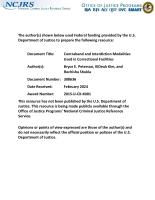Jails
JAILS AND DRUG TREATMENT - A NATIONAL PERSPECTIVE - A REPORT OF SELECTED FINDINGS AND RECOMMENDATIONS OF THE NATIONAL JAIL RESOURCES STUDY
National Directory of Corrections Construction, 1986
Jail Overcrowding and Pretrial Detention - An Evaluation of Program Alternatives
Differential Use of Jail Confinement in California: A Study of Jail Admissions in Three Counties. Executive Summary
Big Help for a Small Jail
Jail Overcrowding and Pretrial Detention - An Evaluation of Program Alternatives - Executive Summary
Mental Health Services in American Jails: A Survey of Innovative Practices
American Jail Death-Rates - A Comparison of the 1978 and 1983 Jail Census Data
Prison and Jail Health Care - A Selected Bibliography
Evaluation of Jail Training Programs
Management of Special Populations: Mentally Disabled Offenders: Final Report
State of the Art in Jail Drug Treatment Programs
Outcome Evaluation of Jail-Based Drug Treatment: Effects on Recidivism
Development of a Microcomputer Software System Prototype for Jail Information in Washington State: Executive Summary
Stress, Setting, and Satisfaction - The Final Report of the Man-Jail Transactions Project
Dealing Effectively With Crowded Jails - A Manual for Judges
Adapting a Dialectical Behavior Therapy Skills Group Within a Jail Setting: Implementation Challenges and Considerations
Deploying Body-worn Cameras in a Jail Setting: Impacts and Lessons Learned
Redesigning Life in U.S. Prisons
The prison system in the U.S. typically places a heavy emphasis on security, control, and punishment, and this foundation can create an adversarial culture within correctional facilities — incarcerated individuals versus correctional staff. But what if that culture could change? What would it look like? How would it impact not only incarcerated individuals but also correctional officers and other staff?



